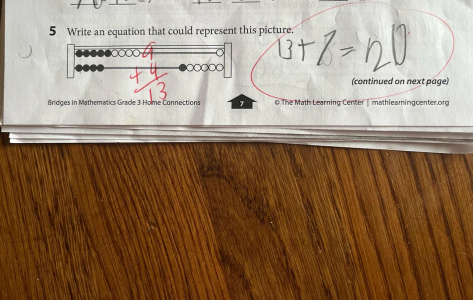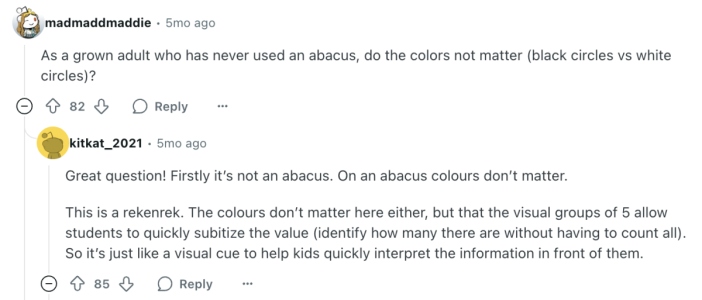The math problem for kids that’s baffling grown-ups—Can you crack the code?
- Replies 0
If you’ve ever tried to help a grandchild with their homework and found yourself scratching your head, you’re not alone!
A math problem meant for 10-year-olds has gone viral after leaving parents—and even some math-savvy adults—completely stumped.
The question, posted on social media’s popular ‘Homework Help’ forum, has sparked a lively debate and a lot of confusion. So, what’s going on? And more importantly, can you solve it?
The Puzzle That’s Puzzling Everyone
Here’s the gist: A parent shared a photo of their child’s third-grade math homework. The question read:
“Write an equation that would represent this picture.”
The picture? A device that looked a lot like an abacus, with rows of beads—some black, some white—arranged on two sides.
On the left, there were nine beads (five black on top, four black on the bottom). On the right, there was one white bead on top and six on the bottom (with just one black bead).
The child’s answer was “13 + 7 = 20.” But the teacher marked it wrong, and the parent was left baffled. Why wasn’t it correct? And what was the right answer?

Internet Weighs In: Abacus or… Rekenrek?
Social media users quickly chimed in, with many admitting they were just as confused. Was it an abacus? Did the colors matter? Should you count all the beads, or just some of them?
The answer, it turns out, lies in understanding what the device actually is.
Source: @2yearlurking_10_19 / Reddit.
While it looks like an abacus, it’s actually a rekenrek—a tool used in many elementary schools to help kids visualize numbers and develop a sense of quantity.
What’s a Rekenrek?
A rekenrek (pronounced “wreck-en-wreck”) is a simple counting frame, usually with two rows of ten beads each, often grouped in sets of five with different colors.
Also try: Think you're smarter than a 5-year-old? This kindergarten homework puzzle has stumped PhDs!
Unlike an abacus, which is used for calculations and place value, the rekenrek is designed to help children “see” numbers and develop mental math skills. The colors are just for grouping—they don’t change the value of the beads.
The Trick: It’s All About the Left Side
So, how do you solve the problem?
Here’s the key: You only count the beads on the left side of the frame. The right side is “out of bounds”—those beads haven’t been moved and don’t count toward the answer.
Also read: Are you smarter than the internet? Try solving this math puzzle that's baffling everyone online!
The confusion comes from overthinking the colors or trying to count all the beads.
The rekenrek is meant to help kids quickly recognize groups of numbers (a skill called “subitizing”) without having to count each bead individually.
Why Are Adults Getting Stumped?
If you’ve never used a rekenrek, you’re in good company! Many adults grew up with the abacus or just pencil-and-paper math. The rekenrek is a newer tool in American classrooms, and its rules aren’t always obvious.
Can you come up with your own rekenrek puzzle to stump your friends or family? Share it below and see who can solve it first!
Read next: It looks easy… until it isn’t. This math riddle is breaking brains

Have you ever been stumped by a child’s homework? Did you use an abacus or other math tools growing up? What do you think of these new teaching methods? We’d love to hear your stories, tips, and questions in the comments below!
A math problem meant for 10-year-olds has gone viral after leaving parents—and even some math-savvy adults—completely stumped.
The question, posted on social media’s popular ‘Homework Help’ forum, has sparked a lively debate and a lot of confusion. So, what’s going on? And more importantly, can you solve it?
The Puzzle That’s Puzzling Everyone
Here’s the gist: A parent shared a photo of their child’s third-grade math homework. The question read:
“Write an equation that would represent this picture.”
The picture? A device that looked a lot like an abacus, with rows of beads—some black, some white—arranged on two sides.
On the left, there were nine beads (five black on top, four black on the bottom). On the right, there was one white bead on top and six on the bottom (with just one black bead).
The child’s answer was “13 + 7 = 20.” But the teacher marked it wrong, and the parent was left baffled. Why wasn’t it correct? And what was the right answer?

A maths problem intended for third graders confused many parents, who struggled to interpret the associated picture and find the correct answer. Image source: @2yearlurking_10_19 / Reddit.
Internet Weighs In: Abacus or… Rekenrek?
Social media users quickly chimed in, with many admitting they were just as confused. Was it an abacus? Did the colors matter? Should you count all the beads, or just some of them?
The answer, it turns out, lies in understanding what the device actually is.
Source: @2yearlurking_10_19 / Reddit.
While it looks like an abacus, it’s actually a rekenrek—a tool used in many elementary schools to help kids visualize numbers and develop a sense of quantity.
What’s a Rekenrek?
A rekenrek (pronounced “wreck-en-wreck”) is a simple counting frame, usually with two rows of ten beads each, often grouped in sets of five with different colors.
Also try: Think you're smarter than a 5-year-old? This kindergarten homework puzzle has stumped PhDs!
Unlike an abacus, which is used for calculations and place value, the rekenrek is designed to help children “see” numbers and develop mental math skills. The colors are just for grouping—they don’t change the value of the beads.
The Trick: It’s All About the Left Side
So, how do you solve the problem?
Here’s the key: You only count the beads on the left side of the frame. The right side is “out of bounds”—those beads haven’t been moved and don’t count toward the answer.
Also read: Are you smarter than the internet? Try solving this math puzzle that's baffling everyone online!
- Top row, left side: 5 beads
- Bottom row, left side: 4 beads
- Total: 5 + 4 = 9
The confusion comes from overthinking the colors or trying to count all the beads.
The rekenrek is meant to help kids quickly recognize groups of numbers (a skill called “subitizing”) without having to count each bead individually.
Why Are Adults Getting Stumped?
If you’ve never used a rekenrek, you’re in good company! Many adults grew up with the abacus or just pencil-and-paper math. The rekenrek is a newer tool in American classrooms, and its rules aren’t always obvious.
- Colors don’t matter: They’re just for grouping.
- Only count beads moved to the left: The rest are ignored.
- No need to add both sides: The right side is just the “unused” beads.
Can you come up with your own rekenrek puzzle to stump your friends or family? Share it below and see who can solve it first!
Read next: It looks easy… until it isn’t. This math riddle is breaking brains
Key Takeaways
- A maths problem intended for third graders confused many parents, who struggled to interpret the associated picture and find the correct answer.
- The question asked to “write an equation that would represent this picture”, showing an abacus-like device with black and white beads, causing confusion over whether bead colours mattered.
- The correct answer required only counting the number of beads moved to the left side (top plus bottom), regardless of their colour, as the tool shown was actually a 'rekenrek', not a traditional abacus.
- Many adults were unfamiliar with the rekenrek and its use in helping children visually subitise numbers, highlighting how modern maths teaching tools can perplex those not taught with them.
Have you ever been stumped by a child’s homework? Did you use an abacus or other math tools growing up? What do you think of these new teaching methods? We’d love to hear your stories, tips, and questions in the comments below!







